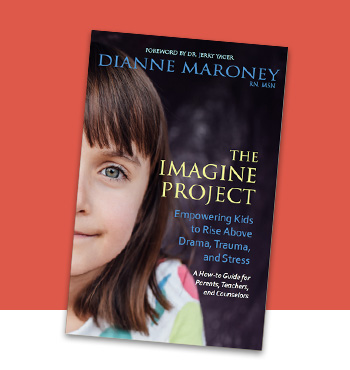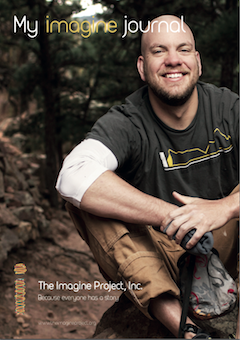Tools to use TIP in Classrooms, Youth Programs, with Individuals, or Groups
Using The Imagine Project in Classrooms, Youth Programs, with Individuals, or Groups
My Imagine Journal™ is an interactive 7-step expressive writing activity that gives kids, teens, and even adults the opportunity to reflect on difficult life stories that may be holding them back, let them go, and imagine a new story in its place. This powerful tool increases self-awareness, builds resilience, helps manage stress, and gives kids a positive direction in life—supporting emotional and mental health—all while getting them excited about writing!
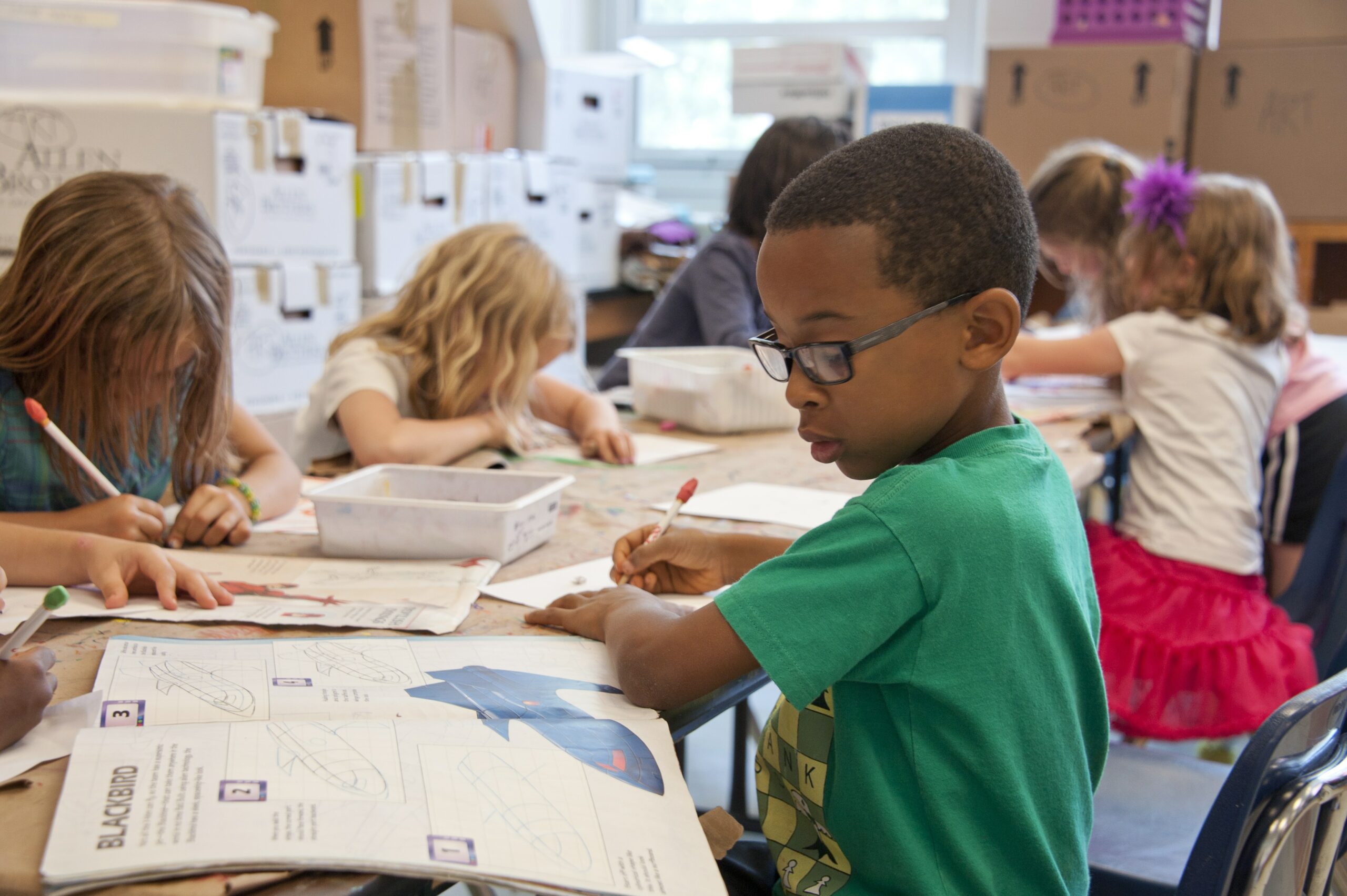
How to use The Imagine Project
Below is all the information you need, including lesson plans, videos, and music suggestions for the writing process. The Imagine Project can be incorporated into various subjects such as literacy, wellness, mindfulness, multicultural units, autobiography, or anywhere it best supports students’ emotional wellness through writing. It can be used once, but we encourage using it over and over again whenever there is a need for emotional expression with a student, group, or classroom. This project equips children with a lifelong tool to support their emotional health. If you feel you need more instruction you can watch our webinar we have created.
Journals Available:
All journals are available to download for FREE in English and Spanish, and they can be typed on digitally, or printed.
Please email Dianne at [email protected] with any questions. Thank you!
K-2: Kindie Journal
The Imagine Project is a perfect way to begin the school year. Here is a letter you can send home to parents so they can participate and learn about The Imagine Project. Then when there are any emotional bumps in the road for students or in the classroom, students are already familiar with the Imagine writing process and can write another Imagine story in their Imagine spirals! Attaching the Feelings Wheel to the back of the spiral is very helpful in writing about emotions.
- Click here for a videotaped version of a teacher reading Byron in English.
- Click here for a video in Spanish
- Watch Lauren Zuiker teaching her 2nd graders how to write their Imagine story using the book “Corduroy” as an example.
- Lesson plan
- Ideas for infusing The Imagine Project into your classroom.
- Download our classroom presentation slides
- Feelings Wheel (Created by Bret Stein)
- How to use The Imagine Project with Second Step Grades K-2
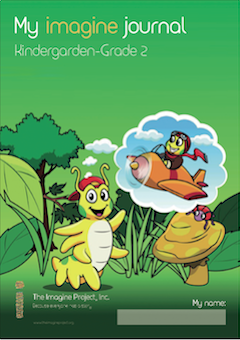
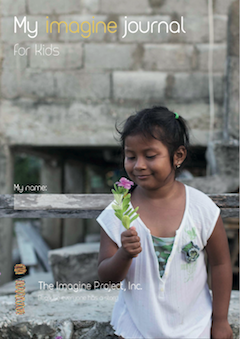
Grades 2-5: Kids Journal
The Imagine Project is a perfect way to begin the school year. Here is a letter you can send home to parents so they can participate and learn about The Imagine Project. Then when there are any emotional bumps in the road for students or in the classroom, students are already familiar with the Imagine writing process and can write another Imagine story in their Imagine spirals! Attaching the Feelings Wheel to the back of the spiral is very helpful in writing about emotions.
Here are more videos of kids telling their Imagine story and talking about the project
Grades 6-12: Journal
The Imagine Project is a perfect way to begin the school year. Here is a letter you can send home to parents so they can participate and learn about The Imagine Project. Then when there are any emotional bumps in the road for students or in the classroom, students are already familiar with the Imagine writing process and can write another Imagine story in their Imagine spirals! Attaching the Feelings Wheel to the back of the spiral is very helpful in writing about emotions.
Videos for teens (some are intense and may not work for younger teens, watch them first)
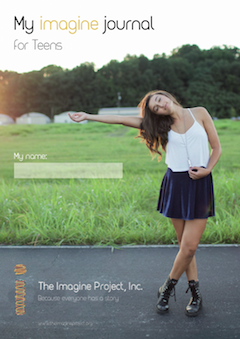
More Helpful Tools
The Imagine Project is a perfect way to begin the school year. Click below for a letter you can send home to parents so they can participate and learn about The Imagine Project. Then when there are any emotional bumps in the road for students or in the classroom, students are already familiar with the Imagine writing process and can write another Imagine story in their Imagine spirals! Attaching the Feelings Wheel to the back of the spiral is very helpful in writing about emotions.
Download a Parent Letter you can use to send to parents before doing the project (if you’d like).
Accommodations and Scaffold Ideas for kids with varying strengths.
Videos: Here are various videos you can use throughout your lesson planning, while working with the students doing The Imagine Project, or for a greater understanding of The Imagine Project:
- Listen to Todd Daubert, a 31 year teaching veteran talks about using The Imagine Project weekly.
- Click here to have your child/student watch the video of Dianne leading teens through the writing process. For Middle and High School age teens.
- Use this video as an introduction to the project: Imagine Project Intro video
An inspiring video that will help the kids when they are getting ready to write about new possibilities in their lives: Greatness Within ft Motivational Video with Les Brown.
Here is an awesome Beyonce video that I sometimes use at the end to inspire the kids to make a mark on the world: I was here.
Music Suggestions for Each Step
- Step 1: “Beautiful” by Christina Aguilera
- Step 2: “Story of My Life” by One Direction
- Step 3: “Into Dust” by Mazzy Star, “Lean on Me” by Bill Withers
- Step 4: “Just Imagine It” by MKTO
- Step 5: “Brave” by Sara Bareilles
- Step 6: “Fight Song” by Outfit Studios
- Other songs: “Roar” by Katy Perry, “Imagine” by John Lennon
DO:
- Encourage students to share their stories if they feel comfortable.
- Applaud their courage and compassion.
- Teach compassion and respect as others share their stories.
- Have students choose a positive word that aligns with their story to boost confidence.
Don't
- Force students to share if they’re not comfortable.
- Send them home emotionally raw after writing intense stories without support.
- Try to “fix” their emotions—be a compassionate listener.
Professional Development for your School or Organization
The Imagine Project is simple, effective, and easy to implement–and we want to make it as easy as possible for everyone to use! Many teachers, counselors, admin, etc. ask if it’s possible to have Dianne or one of our staff members present The Imagine Project to their colleagues as a Professional Development day. Here are some options we recommend:
- Dianne or another staff member can come to your school or district to present–using zoom or Skype is also a possibility. Email Dianne via this website for more information.
- Via this site’s email, ask for a powerpoint/keynote presentation you can use to present to your colleagues. Be sure to include who you are presenting to and how much time you’ll have to present. We recommend leading your staff through the writing process so they can get a good feel for how it works, but it’s not absolutely necessary.
- Have the staff/coworkers read the book: The Imagine Project: Empowering Kids to Rise Above Drama, Trauma, and Stress and have a book club sharing about how you might implement it in your school/classroom (email to ask for a bulk discount).
We’ve created a video class to use for Professional Development in your schools and/or youth organizations. Parents can watch it too. The video is an hour long, give yourself a good hour to an hour and 30 minutes to watch it and write your own story (if you’d like). The sound/video sink quality could be better in the beginning, but you won’t see it during the class. Thank you so much and happy imagining!
For Schools/Profesionals
The Imagine Project is designed to be simple, effective, and easy to implement—and we’re committed to making the process accessible for everyone! Many teachers, counselors, administrators, and others often ask how they can introduce The Imagine Project to their colleagues. Here are some options we suggest:
- Contact Dianne through this website to request a PowerPoint or Keynote presentation to share with your colleagues. Be sure to mention your audience and how much time you have. We recommend guiding them through the writing process to give them a firsthand experience, though this is optional.
- Encourage your staff or coworkers to read The Imagine Project: Empowering Kids to Rise Above Drama, Trauma, and Stress and consider hosting a book club or discussion on how to implement the project in your school or classroom. (You can email us to inquire about bulk discounts.)
- Dianne or another team member can present to your school or district, either in person or via Zoom or Skype.
Feel free to reach out with any questions at [email protected]. Good luck!
Subscribe and Receive Transformative EFT/Tapping Tips
By downloading our ebook you also agree to receive occasional emails about The Imagine Project.

